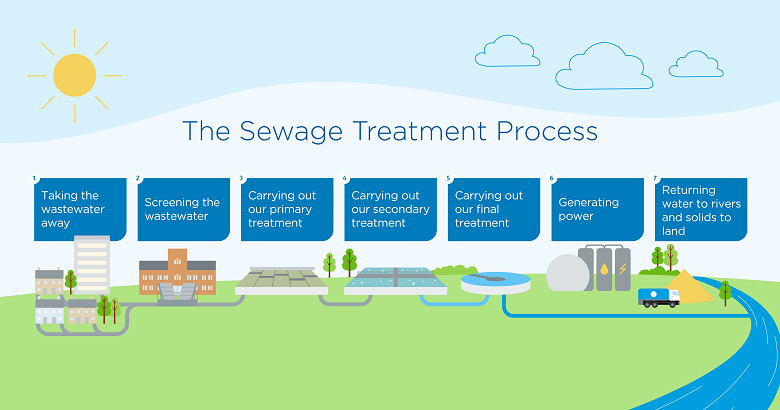Economical Solutions for Large-Scale Waste Water Treatment Facilities
Economical Solutions for Large-Scale Waste Water Treatment Facilities
Blog Article
Strategic Approaches to Improve Drainage Therapy Efficiency and Reduce Environmental Influence
In the world of waste water treatment, the quest for boosted effectiveness and decreased environmental effect is a perpetual obstacle that demands tactical options. The integration of sophisticated therapy innovations, energy-efficient processes, resource healing techniques, boosted nutrient elimination techniques, and clever tracking and control systems represents a complex framework for resolving these pressing concerns.
Advanced Therapy Technologies
Sophisticated membrane filtering systems have reinvented advanced wastewater therapy processes, dramatically enhancing the elimination of contaminants. These ingenious systems function by requiring water via a semi-permeable membrane, successfully separating contaminations from the water stream. The membrane's microscopic pores catch toxins such as bacteria, viruses, and put on hold solids, allowing just detoxified water to pass through. This technology has actually confirmed to be highly effective in getting rid of a large range of pollutants, consisting of pharmaceuticals, heavy steels, and organic substances, which are often challenging to eliminate with standard therapy techniques.
Furthermore, membrane purification systems offer various advantages over standard therapy techniques. They need less room, generate higher-quality effluent, and are much more resistant to changes in influent water quality. Additionally, these systems are highly versatile and can be easily integrated right into existing treatment plants or used as standalone units for decentralized applications. As the need for tidy water remains to rise, the fostering of advanced membrane purification modern technologies is vital to make certain lasting and efficient wastewater treatment practices.
Energy-Efficient Procedures
The combination of energy-efficient procedures in wastewater therapy systems is important for maximizing resource use and lowering operational expenses. By executing energy-efficient technologies, therapy plants can substantially lower their carbon footprint and general ecological impact. One essential technique to boosting power performance in wastewater therapy is the utilization of innovative oygenation systems, such as great bubble diffusers or surface area aerators, which can improve oxygen transfer efficiency and reduce energy intake. Additionally, including energy recovery systems, like anaerobic food digestion for biogas manufacturing or utilizing excess warmth for thermal processes, can assist offset energy needs and advertise sustainability.
Furthermore, optimizing process control and automation via using innovative sensors and keeping track of systems can enhance overall power effectiveness by changing procedures in real-time based upon real need and problems. Executing power audits and regularly keeping track of energy performance indications are necessary techniques to identify locations for renovation and track energy-saving initiatives properly. On the whole, the fostering of energy-efficient procedures in wastewater therapy not only benefits the atmosphere however likewise adds to long-term cost savings and functional sustainability.
Source Recuperation Approaches
With a concentrate on enhancing resource use and sustainability in wastewater treatment systems, the implementation of source recovery methods becomes an essential aspect in improving functional efficiency. Resource recovery techniques in wastewater treatment entail the identification and extraction of beneficial resources from the waste stream, thus turning what was as soon as considered waste right into a useful possession. By carrying out source recuperation techniques such as nutrient removal and recovery, power generation from raw material, and the production of recyclable water, wastewater therapy plants can lessen environmental impact while maximizing effectiveness.

Enhanced Nutrient Elimination Techniques
Carrying out innovative nutrient removal methods is necessary for optimizing the efficiency of wastewater therapy systems. One of the crucial methods used for improved nutrient removal is the procedure of biological nutrient removal (BNR), which includes the removal of nitrogen and phosphorus with organic processes.

In enhancement to BNR, advanced treatment approaches such as membrane bioreactors (MBRs) and created marshes can also be used to enhance nutrient elimination performance. By incorporating these advanced nutrient removal techniques into wastewater treatment sectors, systems and districts can properly lower nutrient contamination and secure the environment.
Smart Monitoring and Control Equipment
Using innovative technology, the assimilation of wise tracking and control systems revolutionizes the functional effectiveness of wastewater therapy centers. These systems incorporate innovative sensing units and data analytics to continually keep track of key parameters such as pH degrees, turbidity, liquified oxygen, and flow go right here rates in real-time. By collecting and analyzing this information, operators can obtain useful insights right into the performance of the therapy processes, making it possible for positive modifications to enhance therapy effectiveness.
Smart surveillance and control systems likewise sustain remote monitoring abilities, allowing operators to accessibility real-time data and control features from off-site locations. This remote availability enhances operational adaptability and responsiveness, making it possible for swift treatments in case of system malfunctions or fluctuations in influent top quality. The predictive maintenance capacities of these systems help stop tools failings and minimize downtime, ultimately boosting the overall reliability of wastewater treatment procedures.
Verdict
To conclude, critical approaches such as sophisticated treatment innovations, energy-efficient procedures, source recuperation strategies, improved nutrient removal methods, and wise tracking and control systems play an important duty in boosting wastewater therapy performance and minimizing environmental impact. By carrying out these strategies, wastewater therapy plants can boost their total efficiency, minimize power usage, recuperate useful sources, and make sure compliance with ecological laws. These approaches are important for sustainable and efficient wastewater administration methods.

In verdict, calculated strategies such as advanced therapy technologies, energy-efficient procedures, source recovery methods, boosted nutrient elimination methods, and clever monitoring great post to read and control systems play a critical role in improving wastewater treatment efficiency and lessening ecological impact.
Report this page